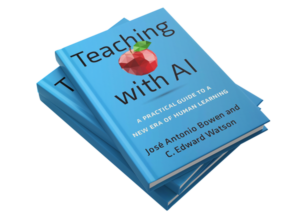With the age of artificial intelligence (AI) well underway, how we work, learn, and conduct business continues to transform and open the door to new opportunities. In the classroom, AI can be a powerful teaching tool and support innovative and interactive learning techniques and critical thinking. Dr. C. Edward Watson, Associate Vice President for Curricular and Pedagogical Innovation with the American Association of Colleges and Universities (AAC&U) and formerly Director of the Center for Teaching and Learning at the University of Georgia, explores how AI is revolutionizing the future of learning and how educators can adapt to this new era of human thinking in his new book, Teaching with AI: A Practical Guide to a New Era of Human Learning (Johns Hopkins University Press).
“AI is a significant game changer and is presenting a new challenge that is going to be dramatically different from past disruptive innovations,” says Watson. “Goldman Sachs and other sources estimate that two-thirds of U.S. occupations will be impacted by AI.1 With a vastly accelerating expectation within the workforce that new graduates will be able to leverage AI for work, there is a growing pressure on institutions of higher education to ensure students become well-versed in AI techniques. This new learning outcome for higher education is being termed AI literacy.”
 AI is also introducing a new academic integrity challenge including how to accurately determine if students are using AI to complete assignments. Along with Teaching with AI co-author, José Antonio Bowen, Watson explores crucial questions related to academic integrity, cheating, and other emerging issues in AI-powered education. “The real focus of the book is how to create assignments and practices that increase the probability that students will engage with the work rather than turn to AI, as well as ways to partner with AI and use these tools in meaningful and impactful ways. Instead of fearing AI and how students may misuse it, the education community must employ logical pedagogical practices within the classroom that encourage our students to become competent partners with AI, including building AI literacy skills that will help them on their future career paths.”
AI is also introducing a new academic integrity challenge including how to accurately determine if students are using AI to complete assignments. Along with Teaching with AI co-author, José Antonio Bowen, Watson explores crucial questions related to academic integrity, cheating, and other emerging issues in AI-powered education. “The real focus of the book is how to create assignments and practices that increase the probability that students will engage with the work rather than turn to AI, as well as ways to partner with AI and use these tools in meaningful and impactful ways. Instead of fearing AI and how students may misuse it, the education community must employ logical pedagogical practices within the classroom that encourage our students to become competent partners with AI, including building AI literacy skills that will help them on their future career paths.”
“I look forward to discussing the higher education landscape at EdgeCon and exploring suggestions for how we might move forward. We need to acknowledge that AI is going to be an important thread in the education and research industries. Disruption is not always a bad thing, especially in the workforce. AI can help improve efficiencies, reduce costs, increase productivity, and create new job opportunities. In the higher education setting, these tools have the potential to offer personalized learning experiences, strengthen retention, and resolve accessibility issues. Along with the potential challenges this type of technology may introduce, we must also look at the positive opportunities that will arise and how we can better prepare our students for the world that is already waiting for them.”
— Dr. C. Edward Watson
Associate Vice President for Curricular and Pedagogical Innovation,
American Association of Colleges and Universities (AAC&U)

AI in the Classroom and Beyond
With over twenty-five years of experience in faculty and instructional development, Watson is nationally recognized for his expertise in general education, active learning, classroom practice, course design, faculty development, student learning, and learning outcomes assessment. “I believe in the transformative opportunities that higher education can provide individuals, especially first-generation students like myself,” shares Watson. “When I entered a master’s program in English, I became increasingly interested in the puzzle of how learning works. I wanted to better understand how to make learning more meaningful for students, how to engage them, and how to ensure what I’m teaching is not just memorized for an exam, but will be remembered and utilized long after the course is completed. As I advanced in my career, I was able to take what I learned helping students in my own classroom to provide programming and opportunities that could benefit the breadth of higher education.”
Even though change can be slow within the education community, Watson says the dramatic, fast shifts happening in the industry are causing many institutions to take notice. “Unfortunately, as higher education begins to adapt, AI is creating new digital inequities. Many institutions are struggling to determine how to best serve their students given the new challenges and opportunities. Institutions will need leaders who continue to explore how advancements like AI are changing their world and the ways in which they can harness and manage AI as a powerful teaching tool.”
“To begin to understand AI and its capabilities, I recommend that faculty copy and paste a current assignment into two or three different AI tools to better understand the opportunities, restrictions, and surprises. This can provide insight into ways to improve the assignment and to make it better aligned with the way students might be expected to complete similar work in the real-world post graduation. I think going forward, we will see AI more deeply integrated within systems we already depend upon. For instance, within learning management systems (LMS), it’s foreseeable that when tudents submit assignments, the AI-assisted LMS will check for AI, plagiarism, and may even grade and provide customized feedback using a faculty designed rubric.”
From a teaching perspective, AI can also be beneficial in helping instructors create rubrics and improve the quality of their course syllabus and assignments. “I hope more faculty look at AI as a toolbox, rather than something to fear,” says Watson. “Teachers are still the experts in their field, and AI can help them elevate their courses and find new ways to improve the learning experience. AI is not a search engine; it is more like a knowledgeable colleague. Using it is more about prompt engineering and having a conversation that fine tunes the results. Faculty should see AI as an idea generator that could be leveraged and helpful with many aspects of the classroom and beyond.”
ChatGPT, a chatbot developed by OpenAI and launched in November 2022, is a common AI tool used to automate tasks, compose essays and emails, and have human-like conversations. According to a recent survey conducted by Study.com, 89 percent of students over the age of 18 have used ChatGPT to help with homework, while 48 percent confessed they had used it to complete an at-home test or quiz.2 “While many students are familiar with AI tools like ChatGPT, not all educators are aware of its prevalence, causing a disconnect,” says Watson. “Showing faculty how this tool can be useful is key and encouraging them to have open and honest conversations with students about how AI can be used as a tool of learning, rather than a way to cheat on their schoolwork is now an essential early-in-the-semester conversation. Instead of approaching AI with how it is breaking your pedagogy, consider how AI is relevant for what you would like to accomplish in preparing your students for the future.”
“I hope more faculty look at AI as a toolbox, rather than something to fear. Teachers are still the experts in their field, and AI can help them elevate their courses and find new ways to improve the learning experience. AI is not a search engine; it is more like a knowledgeable colleague. Using it is more about prompt engineering and having a conversation that fine tunes the results. Faculty should see AI as an idea generator that could be leveraged and helpful with many aspects of the classroom and beyond.”
— Dr. C. Edward Watson
Associate Vice President for Curricular and Pedagogical Innovation,
American Association of Colleges and Universities (AAC&U)
Adapting Higher Education in a New Era
With a theme of Excelling in a Digital Teaching and Learning Future, EdgeCon Spring 2024 will welcome Dr. Watson as a keynote speaker to explore how higher education is evolving and ways to overcome the challenges the industry is facing. “A recent Gallup survey shows a steep decline in how higher education is perceived in this country3,” says Watson. “Less than half of Americans have confidence in higher education. All of us within our industry should consider how we can positively impact this national perception of higher education as there are ramifications. Not preparing students for what will certainly be an AI-enhanced career or recklessly using AI detection tools in ways that might unjustly accuse significant numbers of students of cheating can be significantly dangerous for higher education. Combining such practices with the ongoing student debt crisis and a politically polarized higher education dynamic, and more and more students will question if higher education is still as important as it once was. Already many ask if higher education is still a cornerstone of the American Dream.”
“I look forward to discussing the higher education landscape at EdgeCon and exploring suggestions for how we might move forward,” continues Watson. “We need to acknowledge that AI is going to be an important thread in the education and research industries. Disruption is not always a bad thing, especially in the workforce. AI can help improve efficiencies, reduce costs, increase productivity, and create new job opportunities. In the higher education setting, these tools have the potential to offer personalized learning experiences, strengthen retention, and resolve accessibility issues. Along with the potential challenges this type of technology may introduce, we must also look at the positive opportunities that will arise and how we can better prepare our students for the world that is already waiting for them.”


